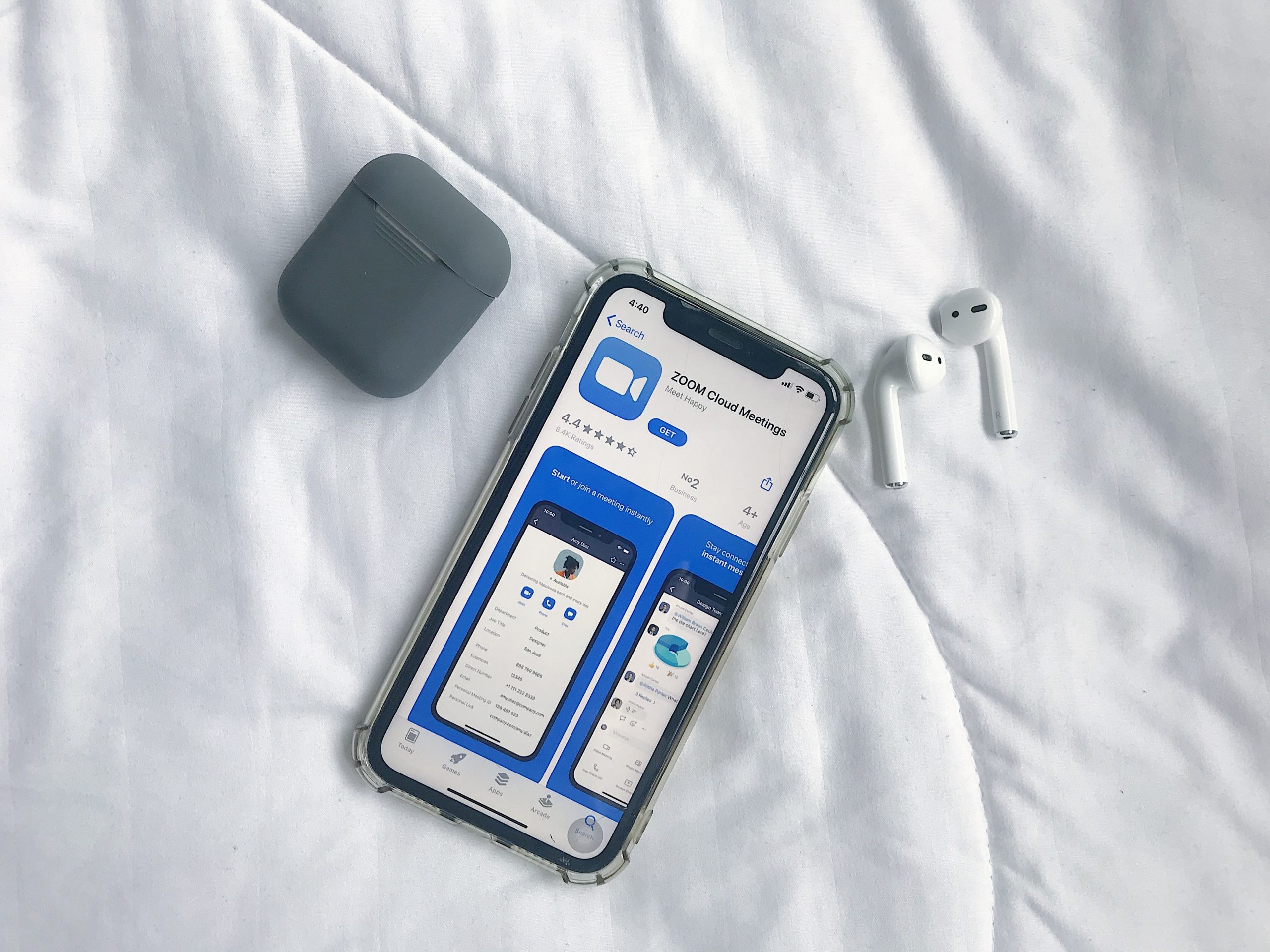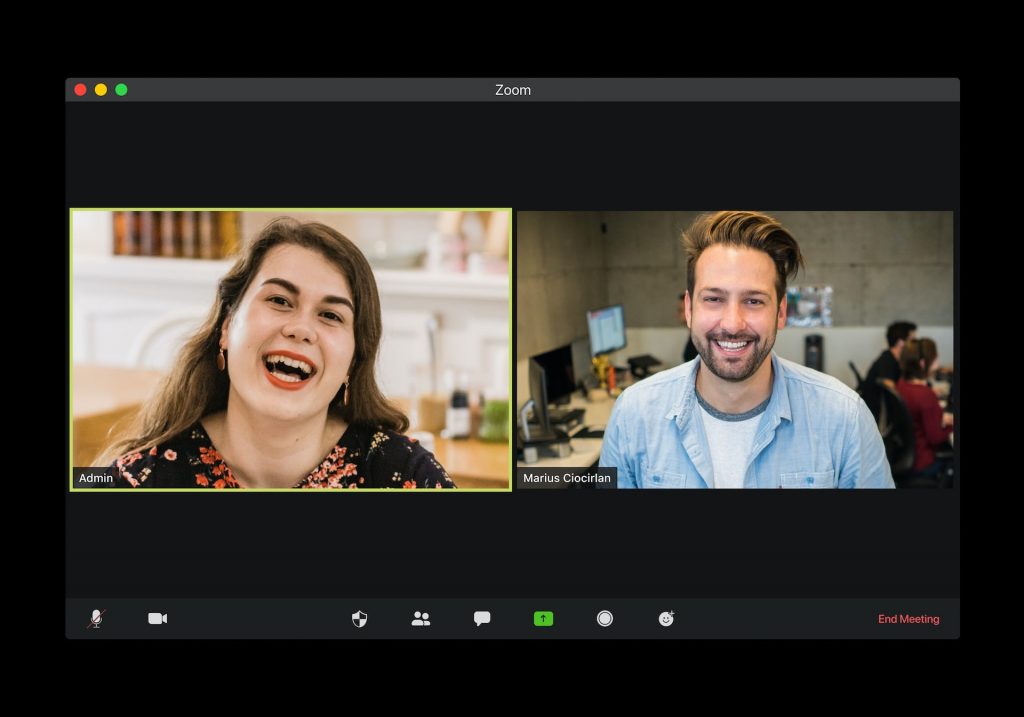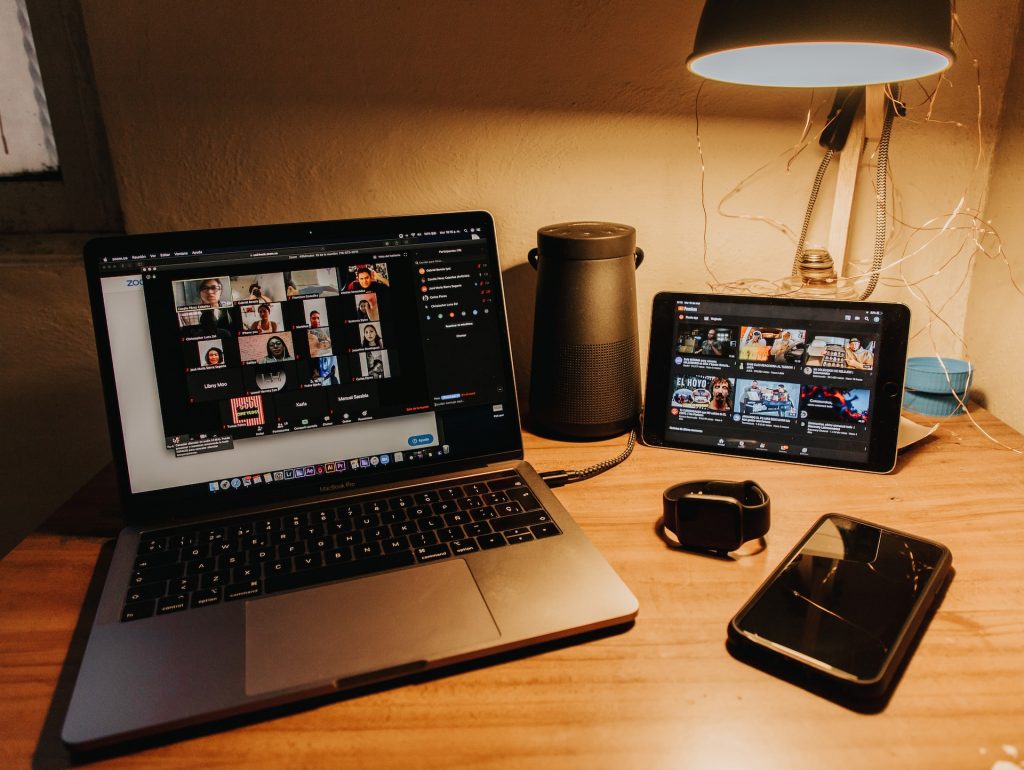
How Does Zoom Work? Video Conferencing Technology Explored — The Tech Behind Series
Jerry Wallis
18 min read

What Is Zoom & What Does It Do? 🎦

Zoom is a top-rated video conferencing platform that allows you to host meetings, webinars, and more with anyone worldwide. It’s effective for both businesses and individuals who want to stay connected online. Zoom is easy to use and offers a variety of features, such as HD video and audio, the ability to share screens, phone dial-ins, cloud recordings, whiteboarding capabilities, and much more.
In addition to video conferencing, Zoom offers chat functions that allow users to communicate via text message or in group chat rooms. They provide a range of collaboration tools, including file sharing and virtual background options, so that everyone can have a professional look during calls. What’s more, Zoom has built-in security features like end-to-end encryption to protect your data from unauthorised access. You can set up meeting passwords for added protection.
Zoom has become one of the most popular tools for remote teams thanks to its many features that make it easy for people to connect and collaborate with colleagues near or far. Its user-friendly design and robust components have become invaluable for full-time employees and freelancers working remotely from home or in different parts of the world. In addition, its flexibility allows users to create rooms with custom settings that cater specifically to their needs allowing them to work together quickly and efficiently while staying secure simultaneously.
But how does Zoom work? Before we dig deeper into Zoom’s technical side, let’s look at the history of video conferencing technology from 1920 to now.
A Brief History Of Video Conferencing Technology ⌛
Video conferencing technology has been around since the late 19th century when the first experimental two-way video calls were made. A commercially available videophone service was first introduced in 1927 by AT&T in the United States and eventually rolled out globally. Over the years, these early video-calling systems evolved into large-scale satellite-based broadcasting networks used for remote meetings, distance learning and telemedicine applications.
Today’s web-based video conferencing systems are an even more advanced version of these earlier technologies. These newer versions use high-speed internet connections such as DSL and cable modem broadband networks to support multiple users on a single channel. In addition, most modern-day services provide robust audio and video quality and features such as screen sharing, whiteboard collaboration, and multi-participant chat sessions.
In recent years, mobile devices have become instrumental in further advancing the video conference technology market, with products like Skype and FaceTime being used to facilitate conversations anytime, anywhere. Such products have opened up a whole new range of possibilities for businesses seeking to collaborate virtually while physically located away from each other. They also allow people to stay connected with friends and family across geographical boundaries despite being physically apart.
Moreover, cloud-based solutions have further revolutionised the industry, with providers like Zoom using their platforms to deliver enterprise-grade services for online meetings, webinars and virtual classrooms, amongst many others. WebRTC (Web Real-Time Communication) is another relatively new technical feature offering browser-to-browser real-time communication without requiring plugins or additional software installations. This has enabled users to launch conferences quickly without downloading or learning to use any particular software platform.
The rise of 5G networks (see how 5G works & the 6G future) is expected to be yet another game changer for this industry, with speeds reaching up to 10x faster than current 4G standards, thus allowing for even better real-time streaming capabilities, which will open up many more opportunities for business collaboration on a global scale between remote teams spread across different locations. This could mean significant improvements in scalability and ease of access, making it easier for companies looking to benefit from this technology on a grander scale while connecting people from all walks of life, no matter how far apart they may be geographically.
The Tech Behind Zoom — How Does Zoom Work? ⚙️
Now that you know the history, let’s understand the tech behind Zoom.
Zoom is built on a complex technology stack that includes a variety of programming languages, frameworks, and cloud-based services. The core technology behind Zoom is a proprietary video conferencing software that uses a combination of WebRTC, TCP/IP, and UDP protocols to deliver high-quality audio and video streams to users.
Zoom’s backend infrastructure is built using a microservices architecture that relies heavily on cloud-based technologies such as Amazon Web Services (AWS) for storage, computing, and networking. The front end of Zoom is built using various technologies such as ReactJS, Webpack, and Sass. In addition, Zoom leverages machine learning and natural language processing algorithms to power its virtual background and transcription features. It offers APIs that allow developers to integrate Zoom’s capabilities into their own applications.
Furthermore, Zoom uses cloud computing and web technologies to create a virtual space where users can connect over audio, video, or text chat. This allows for easy collaboration, as well as allowing for screen sharing if needed. For example, to join a meeting, users simply have to enter the meeting room URL or ID provided by the host, and they are instantly connected.

The technical backbone of Zoom is based on two key protocols: Session Initiation Protocol (SIP) and Real Time Messaging Protocol (RTMP). SIP is used for signalling, including session initiation and controlling, while RTMP is responsible for real-time media delivery between endpoints in the conference room. Additionally, it uses WebRTC technology, which provides one-click connectivity between all clients in the conference regardless of their device or operating system.
The platform has been optimised for scalability and performance, allowing it to support meetings with thousands of participants simultaneously. This scalability also ensures that meetings don’t experience sudden drops in quality when more people join during peak hours. Moreover, Zoom offers quick setup via various apps available across platforms like Windows, MacOS, Android, iOS etc. Plus, there are dedicated mobile apps for each platform as well. This allows anyone wishing to participate to join or host a call almost instantly without requiring any additional setup aside from downloading the app or entering via a browser link (if available).
On a different note, security protocols such as AES 256-bit GCM encryption are employed at both ends of the connection so that only those invited can access the call; this helps ensure privacy during meetings while also keeping malicious actors away from accessing private information shared within these calls. Other than that, Zoom also supports additional security measures like password-protected rooms plus waiting rooms via the Zoom Rooms feature, which allows hosts to control who can join the call before they are accepted into the chatroom.
The Video Architecture Of Zoom — The Tech Stack 👨💻
🏙️ Distributed Architecture
Zoom’s video architecture is based on a distributed network, which means that the video conferencing system is spread across multiple servers and locations to ensure high scalability and reliability. In this architecture, each component, such as video processing, audio processing, media routing, and user management, is managed by separate servers to reduce the load on a single server and to improve performance. This also allows the system to handle large numbers of users and provide a high-quality experience, even during peak usage.
🖥️ Multimedia Routing
Zoom’s video architecture also includes a multimedia routing system that is responsible for routing and managing the video, audio, and data streams between participants in a conference. This routing system is designed to handle multiple streams of varying quality levels and to dynamically adjust the quality of each stream based on network conditions and participant requirements.

🎞️ Multi-Bitrate Encoding
Zoom uses multi-bitrate encoding to ensure the best possible video quality for each participant. This means that the video is encoded at multiple quality levels, with each level optimised for different network conditions. The system can then select the appropriate quality level for each participant based on their network conditions, ensuring they receive a high-quality video stream even in low-bandwidth situations.
👨🔧 Application Layer Quality of Service
Zoom’s video architecture also includes an application layer quality of service (QoS) mechanism designed to prioritise the video and audio streams over other network traffic. This ensures that the video and audio streams are delivered with low latency and high quality, even when the network is congested. The QoS mechanism also provides real-time monitoring of network conditions, allowing the system to dynamically adjust the quality of the video and audio streams as needed to ensure the best possible experience for all participants.
How Zoom Compares To Other Video Conferencing Software ⚖️
Zoom is one of the most popular video conferencing software solutions currently available, and for a good reason. It offers several features that make it stand out from the other options on the market. For starters, Zoom has an incredibly user-friendly interface that makes it very easy to use. This makes it ideal for businesses or individuals unfamiliar with video conferencing software who need to get up and run quickly. Zoom also offers strong encryption and data protection, making it a secure option for sensitive virtual conversations.
In addition to its user-friendliness, Zoom has several advantages compared to other video conferencing platforms. One key benefit is its scalability; users can add more people to their meetings without sacrificing quality or functionality. This is particularly useful if you’re hosting large conferences or training remotely. In addition, the audio quality is clear even with many people in one meeting.
Another advantage of using Zoom over similar platforms is its range of features and customisation options. Whether you’re hosting a formal business meeting or a casual hangout with friends and family, there are plenty of ways to personalise each experience with backgrounds, filters, and music bots that can help set the right tone for your gathering. You can also record meetings so they can be replayed later on or shared with those who couldn’t attend in person. Furthermore, reactions are used within Chat and during breakouts, so everyone feels included during group discussions no matter where they are geographically speaking. Finally, breakout rooms present another way to keep participants engaged by separating larger groups into smaller ones for focused conversation around specific topics or tasks — perfect for brainstorming sessions!
All these features combine to make Zoom an excellent choice for any video conference event — small-scale personal gatherings and large corporate events requiring extensive customisation capabilities. It’s no wonder why Zoom has become such an industry leader!

⚔️ Zoom Vs Teams & Meet
Zoom, Microsoft Teams, and Google Meet are all popular video conferencing solutions that offer similar core features such as audio and video conferencing, screen sharing, and chat. However, there are some differences between them.
Zoom is known for its ease of use, stable and high-quality video, and comprehensive features such as virtual backgrounds and recording. It also offers a free plan, making it an attractive option for small teams and individuals.
Microsoft Teams is more focused on collaboration and is tightly integrated with the Microsoft Office suite. It offers features such as document sharing and collaboration, project management, and advanced security options. As a result, larger organisations already using Microsoft products often use it.
Google Meet is a cloud-based video conferencing solution that is integrated with Google Workspace, making it a good option for teams that use Gmail and other Google apps. In addition, it offers features such as live captions, real-time collaboration on documents, and integration with Google Calendar. It also has a free plan, making it a popular choice for individuals and small businesses.
Overall, the choice between Zoom, Microsoft Teams, and Google Meet depends on the specific needs of your team or organisation. Each platform has its own strengths and weaknesses, so it’s essential to evaluate them based on the features and functionality that are most important to you.
Features That Make Zoom Stand Out ✨
Zoom stands out with several distinct features. One of the most noteworthy is its ability to host and facilitate large-scale online meetings, with a capacity for up to 100 interactive participants in a single conference. For even larger groups, the platform can accommodate up to 500 participants in a ’view-only’ broadcast mode. In addition, zoom allows users to join meetings from any device — laptops, tablets and smartphones — making it ideal for remote teams and geographically dispersed collaborations.
The platform is loaded with user-friendly features that make running and attending virtual meetings more efficient and productive. These include video conferencing capabilities, audio-video dial-in and chat functions, virtual whiteboards, annotation tools, file-sharing options, private chat rooms and much more. Additionally, Zoom allows users to create custom meeting spaces with specific settings like password protection, enabling them to tailor their virtual experiences according to their needs.
Moreover, Zoom has implemented cutting-edge security measures ranging from secure data transmission through encryption protocols such as TLS 1.2/AES 256-bit GCM encryption to two-factor authentication protocols to protect user accounts against malicious threats like phishing attempts or other hacks. These high-level security measures have made it possible for major organisations like governmental bodies or educational institutions within various industries around the world to trust Zoom’s secure hosting services for important video conferences.
What sets Zoom apart from its competitors is its sheer convenience; users can access their account anytime from anywhere on any device without downloading any software, making it an ideal solution for spontaneous communication needs between team members or clients alike. Furthermore, the platform provides advanced analytics tools that give users insights into usage trends to optimise their experience when utilising the service going forward.

Zoom’s Pricing & Availability 💸
Zoom offers a variety of different pricing plans for businesses and individuals. The basic plan is free and includes unlimited one-on-one meetings, up to 100 participants in group meetings, and 40- minutes session time for group meetings.
Zoom also offers Pro, Business, and Enterprise plans that provide additional features such as custom personal meeting rooms and the ability to record meetings. All Pro, Business and Enterprise plans also offer higher levels of security like encryption and access control. For larger businesses with more than 300 participants, Zoom also has an on-premise solution that allows customers to pay an annual fee to host their server instance.
Regarding availability, Zoom is available across multiple platforms, including Windows, macOS, iOS, Android, Linux, and web browsers such as Chrome and Firefox. Zoom can also be used on mobile devices such as iPhones or iPads through their app store download or on Android devices through their Google Play Store download. Additionally, Zoom has plugins for Outlook that allow users to join scheduled calls from the calendar invite quickly.
Several options for those looking to use Zoom on the go are available depending on the selected pricing plan. Pro subscribers have access to the Zoom Rooms application, which allows them to join a meeting from any conference room thanks to its integration with other popular conference room hardware providers like Polycom or Crestron.
The Business plan also provides access to this feature but with a few added extras, such as enhanced reporting features that help managers track usage of their accounts by individual users or the department. Finally, the Enterprise plan provides all of these features and dedicated technical support teams available 24/7 in case any issues arise during setup or while using the service.
Benefits Of Using Zoom For Business Use 🎖️
📈 Increased Productivity
Zoom enables users to have virtual meetings from anywhere, which helps to increase productivity by reducing the need to travel or commute between locations. Additionally, with features like screen sharing, attendees can quickly and easily view information and presentations without needing physical media like flash drives or printed documents. This eliminates the time it takes to transfer data between parties and encourages more efficient conversations.
💰 Cost Savings
With no additional hardware, video conferencing software like Zoom can provide substantial cost savings compared to traditional meeting methods such as renting conference rooms or business trips. Even better, many providers offer subscription packages that enable businesses to pay only for what they use every month, so there is zero waste in terms of unused services or amenities that could otherwise cost extra money.
📅 More Dynamic Meetings
With interactive features like polling, breakout rooms, and group collaboration tools, Zoom makes it easier to keep participants engaged during virtual meetings while preserving an orderly flow of discussion and decision-making. Additionally, these features are beneficial for helping teams collaborate in real-time regardless of where each individual is located and providing feedback quickly on projects or ideas presented during the call.

🛡️ High-Security Standards
Security is always a significant concern when dealing with sensitive data being exchanged over the internet during a business meeting. Fortunately, Zoom has implemented robust security protocols, including AES 256-bit GCM encryption and TLS 1.2 encryption standards that help ensure any sensitive data shared in virtual conferences remains encrypted and secure from beginning to end without risk of a breach or data theft occurring midway through the call.
💁 Easy To Use
Last but not least, one of the most significant advantages of using Zoom for business use is its simplicity and ease of use – even those who are not tech savvy can navigate the program in minutes thanks to its intuitive user interface design and helpful tutorials available online if needed. Additionally, setting up new accounts with access levels appropriate for each user is incredibly straightforward so that teams can get started quickly without any complications or technical hurdles along the way.
Drawbacks Of Using Zoom For Business Use ⛔
🕵️♂️ Lack Of Privacy Settings
One potential downside of using Zooms’s video conferencing services is that some settings related to privacy may not be configurable enough for certain businesses looking for greater control over who can join their meetings or access particular files shared thereon. This could be due to certain geolocation restrictions imposed by provider policies or limited settings designed into their software platform. That means these issues should hopefully be resolved soon, given recent events related to cybersecurity across multiple platforms.
🦻 Limited Accessibility Features
Another issue Zoom users face is its lack of accessibility options, such as closed captioning support, which affects many users who are hard of hearing and rely on this feature when attending calls. As such, businesses must ensure all employees have proper access before hosting any virtual conferences via this platform so everyone can get their points across effectively without having difficulty understanding others speaking due to an inability to hear them properly through audio alone.
🌐 Potential Network Congestion
Although rare, if too many people try joining your conference at once, then you could run into network congestion issues where all participants suffer from poor-quality audio/video streams. Luckily, Zoom provides support teams who monitor usage patterns constantly, but you might face this problem depending on how large your team/company size gets over time.

⏸️ Interruption Risk From Outside Sources
Just as with other online services, there’s always a risk someone could hijack your meeting by spamming obscene content or launching DoS attacks against you. While most companies take steps towards preventing such occurrences (like relying on third-party solutions), you must remain vigilant against malicious actors at all times so your work isn’t disrupted unexpectedly.
👾 System Bugs & Glitches
Finally, every piece of tech comes with its fair share of bugs/glitches that don’t show up until after launch — while most providers do their best to patch up these issues quickly, sometimes they don’t get fixed immediately, causing disruption or delays in our daily operations — this holds especially when dealing with complex projects involving multiple moving parts which require precision timing from everyone involved. So having fail-safes set up beforehand in case anything goes wrong is essential if you want your plans to run smoothly without undue interruption.
Final Words: How Does Zoom Work? 📋
The best thing about Zoom is that it offers users a convenient and secure way to connect with their friends, family, colleagues, customers, and business partners through a reliable platform. In addition, zoom is incredibly easy to use and provides an intuitive interface that requires minimal learning, even for those who are not tech-savvy. It also has many useful features, such as recording meetings, video conferencing with up to 500 participants, screen sharing, whiteboard collaboration for brainstorming purposes, background blur for improved privacy during sessions, and more.
Furthermore, Zoom is highly secure; third-party auditors have verified its security measures. Moreover, all communications sent through the platform are encrypted with end-to-end encryption technology to protect user data from potential hackers or malicious actors. Users can also put their conversations on mute or leave the group chat anytime if they don’t want to be disturbed or need some privacy.
In conclusion, Zoom is a great tool that allows people to stay connected easily while simultaneously keeping conversations private and secure. If you need more information about Zoom (or any other video conferencing software), feel free to reach out to us for a friendly chat. We’re always happy to help!
Topics
Published On
February 15, 2023

